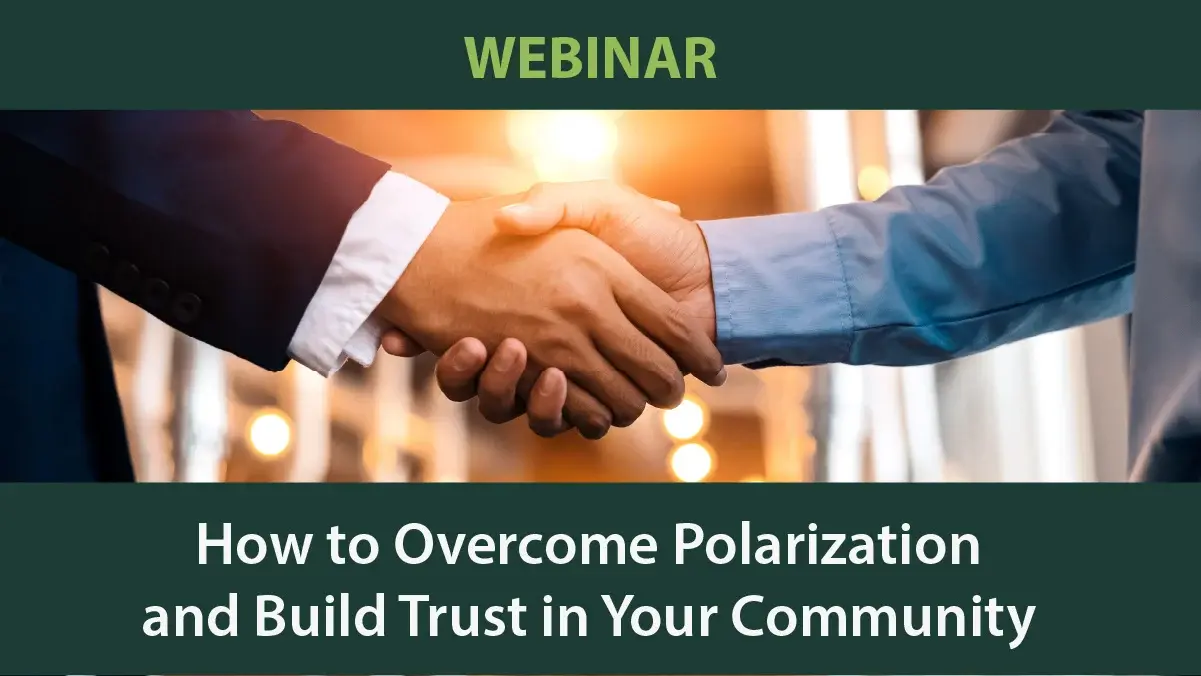How to Overcome Polarization and Build Trust in Your Community
By Polco on January 17, 2025

Polarization is at an all-time high—and it’s not just a national issue.
Local governments often experience the real impact when residents lock horns over everything from noise ordinances and short-term rentals to budget priorities.
In a recent webinar, our panel of experts tackled the big question: How can local government leaders reduce polarization and build trust in their communities?
Key Webinar Highlights
Below are the core themes discussed during the event—plus direct quotes from our panelists and the audience’s Q&A.
1. Why Polarization Matters Locally
“Polarization is Merriam-Webster’s word of the year. It’s everywhere—and it has tangible effects on local decision-making.”
– Michelle Kobayashi
- The Local Impact: Although “polarization” sounds national, it can stall everyday initiatives, from noise ordinances to police budgets.
- Data Point: Fewer than 20% of residents have ever attended a public meeting—so the loudest voices are often the most polarized.
Panel Tip: Short online surveys and text-message polls widen participation, helping you capture more middle-ground perspectives rather than just the extremes.
2. Bringing More Voices to the Table
“When we rely on the same few people, we miss the full spectrum of resident needs. That’s where surveys and new tech come in.”
– Joy Racine
- Multiple Channels: Scottsdale uses online polls, text apps, and in-person workshops—each drawing a different subset of people.
- Culturally Relevant Communication: Providing Spanish-language surveys or rotating meeting times can boost inclusivity.
- Meet People Where They Are: Joy cites putting QR-code signs at dog parks so dog owners can chime in immediately instead of missing an online form later.
3. Focus on Outcomes Instead of Arguments
“Facts alone might not change minds—especially on hot-button issues. Instead, zero in on shared goals.”
– Tom Rossman
- Defining the Issue: Tom advocates starting every meeting with a crystal-clear definition of the problem (e.g., “Downtown noise levels”) so discussions stay on topic.
- Avoid Confrontation: When met with extreme opinions, thank participants for their perspective, and steer the conversation back to common objectives like safety, well-being, and vibrancy.
- Shared Facts: Build trust by clarifying which facts everyone agrees on, then move forward collaboratively.
4. Education & Transparency as Antidotes to Misinformation
“We have to be out there first, consistently sharing accurate info—otherwise someone else’s narrative might take root.”
– Michelle Kobayashi
- Proactive Communication: Hold forums, post frequent website updates, and utilize a variety of social channels so residents know where to find verified data.
- Close the Loop: Show the community how their input shaped the final decision. Even if they disagree with the outcome, people are more accepting if they feel heard.
Panel Tip: Anticipate rumor-prone topics—like special event noise or budgets—and launch an FAQ or dedicated web page before speculation escalates.
5. Real-World Example: The Scottsdale Noise Ordinance
“We thought it’d be a simple ‘turn it down vs. keep it loud’—but by asking why, we found common ground.”
– Joy Racine
- Background: Scottsdale revisited its special noise ordinance, with residents complaining about loud venues and bar owners pushing for vibrant nightlife.
- Approach: City leaders interviewed bar owners, residents, and sound engineers, then hosted in-person forums and online polls.
- Outcome: The process uncovered shared interests—residents weren’t demanding bars shut down, they just wanted reasonable decibel levels and consistent enforcement. The city is now drafting policies addressing both sides’ priorities.
Q&A: Addressing Tough Situations
Q: How do we handle physically threatening or hostile attendees at public meetings?
A (Tom Rossman):
“If someone crosses the line to violence, they have to be removed. You can’t have productive dialogue under intimidation. But set clear ground rules from the start—like ‘no interrupting’ or ‘no personal threats’—so everyone knows the expectations.”
Q: What about local media outlets thriving on controversy?
A (Joy Racine):
“Controversy sells, but you can still be proactive. Keep your own official updates clear, concise, and highly visible. Push them to social media, newsletters, and local organizations. You can’t control sensational news, but you can be a reliable source of clarity.”
Practical Tips to Reduce Polarization
- Offer Multiple Ways to Engage
- Surveys, text polls, and online forums.
- Vary times and locations for in-person events.
- Define the Issue & Stay Focused
- Keep discussions on-topic.
- Summarize shared facts early on.
- Emphasize Shared Outcomes
- Identify common goals (safety, prosperity, fairness).
- Avoid zero-sum language (“winning” vs. “losing”).
- Be Transparent & Close the Loop
- Show how feedback is used.
- Give participants a post-decision summary.
- Stay Empathetic & Vulnerable
- Listen actively.
- Acknowledge real concerns, even if you disagree.
Next Steps: Building More Inclusive Engagement
- Want to try text-message polls or digital surveys?
Check out our Engagement Toolkit for tips on easy, accessible ways to gather feedback. - Looking for benchmark data?
Learn more about The National Community Survey to compare results across hundreds of municipalities. - Need tailored advice?
Contact Our Team to schedule a demo or one-on-one session with a Polco expert.
Final Thoughts
Polarization isn’t going away, but local governments don’t have to be stuck in stalemates. By adopting more inclusive engagement strategies, staying transparent, and focusing on shared outcomes, you can transform heated debates into constructive community dialogue. As our panelists emphasized, residents are more open-minded and collaborative than you might think—if you make it easy for them to be heard.
“A surprising number of people are willing to compromise if they feel listened to. That’s where true progress begins.”
– Michelle Kobayashi
Related Articles
Popular posts
Sign-up for Updates
You May Also Like
These Related Stories

Avoid These Top Ten Common Community Survey Mistakes

How to Make Innovation Successful in Your Community

